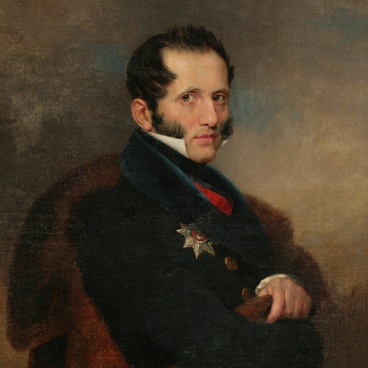One of the best canvases in the collection — the portrait of Alexander I is not completely embedded in the row of the family gallery from the Uvarov estate, but in this situation it represents not only the Romanov dynasty. The dazzling beauty of Princess Maria Antonovna Naryshkina (born Chetvertinskaya), her ability to keep herself in polite society attracted the attention of then Tsarevich Alexander Pavlovich, the future Emperor Alexander I. Her portrait is also on display in the Art Gallery. Their relationship developed into a kind of second, not too secret, family and lasted for fifteen years. According to legend, they had several children who did not live to adulthood.
The old museum inventory books attributed the portrait authorship to Lampi the Elder (1751-1830). After restoration, this name was removed. To date, a number of similar royal portraits have been identified, dating back to one original — a ceremonial portrait by V.L. Borovikovsky. Portraits of emperors were painted in huge circulations, as they adorned many official institutions throughout the country. There are many of them on the Internet. The encyclopedia “Faces of Russian History” describes 149 portraits of the Tsar at different ages and in different techniques. 53 portraits are reproduced, including the famous ceremonial portrait by V.L. Borovikovsky, which served as a model for many images of the Tsar, mostly chest, as at Art Gallery in Murom. All of them differ significantly in the standard of performance. Attribution to Borovikovsky requires separate clarification every time. We have reason to assume that the Murom portrait of Alexander I, if not painted by Borovikovsky himself, then undoubtedly comes from his workshop, it is created with the participation of the master. The sovereign in the Murom portrait is young and beautiful, so can be said about the artist’s work. The painting manner is thin, the colors are translucent with characteristic bluish shadows.
In 1802, Borovikovsky apparently got an urgent order for a full-length portrait of the Tsar. As known, the artist was inundated with orders and sometimes painted only heads. In this case, the situation was more like this — Borovikovsky’s students prepare canvases for large chest portraits, paint a figure on the basis of a ceremonial portrait or simultaneously with it. The master painted the faces. The final decision on authorship can be made only after a technical and technological examination by experienced specialists.
The old museum inventory books attributed the portrait authorship to Lampi the Elder (1751-1830). After restoration, this name was removed. To date, a number of similar royal portraits have been identified, dating back to one original — a ceremonial portrait by V.L. Borovikovsky. Portraits of emperors were painted in huge circulations, as they adorned many official institutions throughout the country. There are many of them on the Internet. The encyclopedia “Faces of Russian History” describes 149 portraits of the Tsar at different ages and in different techniques. 53 portraits are reproduced, including the famous ceremonial portrait by V.L. Borovikovsky, which served as a model for many images of the Tsar, mostly chest, as at Art Gallery in Murom. All of them differ significantly in the standard of performance. Attribution to Borovikovsky requires separate clarification every time. We have reason to assume that the Murom portrait of Alexander I, if not painted by Borovikovsky himself, then undoubtedly comes from his workshop, it is created with the participation of the master. The sovereign in the Murom portrait is young and beautiful, so can be said about the artist’s work. The painting manner is thin, the colors are translucent with characteristic bluish shadows.
In 1802, Borovikovsky apparently got an urgent order for a full-length portrait of the Tsar. As known, the artist was inundated with orders and sometimes painted only heads. In this case, the situation was more like this — Borovikovsky’s students prepare canvases for large chest portraits, paint a figure on the basis of a ceremonial portrait or simultaneously with it. The master painted the faces. The final decision on authorship can be made only after a technical and technological examination by experienced specialists.

